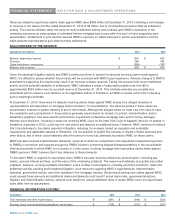GE 2014 Annual Report Download - page 163
Download and view the complete annual report
Please find page 163 of the 2014 GE annual report below. You can navigate through the pages in the report by either clicking on the pages listed below, or by using the keyword search tool below to find specific information within the annual report.
GE 2014 FORM 10-K 143
FINANCIAL STATEMENTS PRESENTATION & POLICIES
Write-offs on larger-balance impaired commercial loans are based on amounts deemed uncollectible and are reviewed
quarterly. Write-offs are determined based on the consideration of many factors, such as expectations of the workout plan or
restructuring of the loan, valuation of the collateral and the prioritization of our claim in bankruptcy. Write-offs are recognized
against the allowance for losses at the earlier of transaction confirmation (for example, discounted pay-off, restructuring,
foreclosure, etc.) or not later than 360 days after initial recognition of a specific reserve for a collateral dependent loan. If
foreclosure is probable, the write-off is determined based on the fair value of the collateral less costs to sell. Smaller-balance,
homogeneous commercial loans are written off at the earlier of when deemed uncollectible or at 180 days past due.
PARTIAL SALES OF BUSINESS INTERESTS
Gains or losses on sales of affiliate shares where we retain a controlling financial interest are recorded in equity. Gains or
losses on sales that result in our loss of a controlling financial interest are recorded in earnings along with remeasurement
gains or losses on any investments in the entity that we retained.
CASH AND EQUIVALENTS
Debt securities and money market instruments with original maturities of three months or less are included in cash equivalents
unless designated as available-for-sale and classified as investment securities.
INVESTMENT SECURITIES
We report investments in debt and marketable equity securities, and certain other equity securities, at fair value. See Note 21
for further information on fair value. Unrealized gains and losses on available-for-sale investment securities are included in
shareownersǯ equity, net of applicable taxes and other adjustments. We regularly review investment securities for impairment
using both quantitative and qualitative criteria.
For debt securities, if we do not intend to sell the security or it is not more likely than not that we will be required to sell the
security before recovery of our amortized cost, we evaluate other qualitative criteria to determine whether we do not expect to
recover the amortized cost basis of the security, such as the financial health of and specific prospects for the issuer, including
whether the issuer is in compliance with the terms and covenants of the security. We also evaluate quantitative criteria
including determining whether there has been an adverse change in expected future cash flows. If we do not expect to recover
the entire amortized cost basis of the security, we consider the security to be other-than-temporarily impaired, and we record
the difference between the securityǯs amortized cost basis and its recoverable amount in earnings and the difference between
the securityǯs recoverable amount and fair value in other comprehensive income. If we intend to sell the security or it is more
likely than not we will be required to sell the security before recovery of its amortized cost basis, the security is also considered
other-than-temporarily impaired and we recognize the entire difference between the securityǯs amortized cost basis and its fair
value in earnings. For equity securities, we consider the length of time and magnitude of the amount that each security is in an
unrealized loss position. If we do not expect to recover the entire amortized cost basis of the security, we consider the security
to be other-than-temporarily impaired, and we record the difference between the security’s amortized cost basis and its fair
value in earnings.
Realized gains and losses are accounted for on the specific identification method. Unrealized gains and losses on investment
securities classified as trading and certain retained interests are included in earnings.
INVENTORIES
All inventories are stated at the lower of cost or realizable values. Cost for a significant portion of GE U.S. inventories is
determined on a last-in, first-out (LIFO) basis. Cost of other GE inventories is determined on a first-in, first-out (FIFO) basis.
LIFO was used for 40% and 39% of GE inventories at 2014 and 2013, respectively.
























